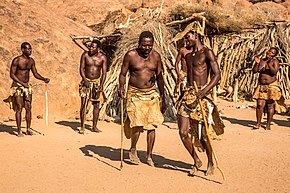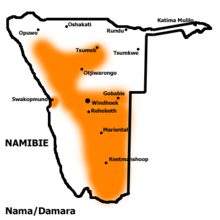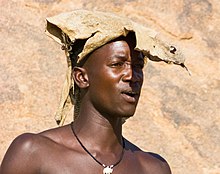Damara
The Damara , rarely and historically also Dama , Bergdamara or Klippkaffern , are an African ethnic group with settlement areas in Namibia.
Popular name
The Damara call themselves ǂNūkhoen , which means black people . In Nama they are called ǃuinida , in Herero ozonduka . The designation Dama or Bergdama ( Damara is actually a female dual form ) is no longer common.
origin
The Damara are believed to be predominantly of black African origin, but speak a language that is similar to that of the Nama and San and is understood as part of Khoekhoegowab . There has been much speculation about their origins, as they are probably not part of the Bantu immigration wave that has poured over the southern part of Africa since the turn of the century. They differ externally from the Khoi Khoi and the San . Nevertheless, the Damara, together with the San, are considered to be the oldest settlers in southern Africa. On the other hand, language and culture have many characteristics like the Khoisan peoples (Khoi Khoi), so that they are often assigned to this group.
Historically, the Damara were, as far as this can be reconstructed, never a dominant ethnic group , but always subject to the other peoples of this area, with the Herero , Nama and Afrikaans they even had slave status for a long time . The Damara enjoyed a certain esteem among these peoples because they had mastered the art of iron and copper smelting and forging - skills that were very important in the manufacture of spears and arrows. The domination by other tribes led to a gradual but very extensive loss of cultural identity.
habitat
In Namibia they make up around 8% of the population (1994 estimate: 132,000). In connection with the Odendaal Plan , the apartheid regime in South Africa established Damaraland in 1973 as a homeland for the Damara between Kaokoland and the Namib fringe zone. Today the Damara live in mostly poor conditions from horticulture and cattle breeding or from mining in the so-called "copper triangle".
Religion and culture
The fear of the dead and the cult of the healer are of great importance. The “Speisemeisterei” (preliminary tasting) and initiation celebrations (young men are prepared for their life as hunters) also play an important religious role.
Traditionally, surnames among the Damara are different between the female and male sex. The surnames of men always end with b , those of women with s . An example of this is Hage Geingob , while his wife was named Geingos .
Famous Damara
- Jackson Kaujeua (1953-2010), musician
- Frank Fredericks (* 1967), track and field athlete
- Collin Benjamin (* 1978), football player
Trivia
The Damarafaltengebirge is named after the Damara and was formed 650–500 million years ago by the collision of the Congo Craton and the Kalahari Craton . The sea connection ( Damara Sea ) that previously existed at this point was closed. The marine sediments that were transported to the surface of the earth during the collision have now largely been removed. Today there are exposed granite rocks (Damara granite) in many places, especially in Namibia, which were formed as underground magmatic intrusions during the bulge.
Other names after the ethnic group include the Damara tern ( Sterna balaenarum ), Damara-Dikdik and Damaraland (former homeland in South West Africa ).
See also
literature
- Seth Boois: Reflections on Modern Damara History , Khorixas 2017.
- Adi Inskeep: Heinrich Vedder's “The Bergdama”. An annotated translation of the German original with additional ethnographic material, Volumes I and II, Köln, Köppe, 2003
- Heinrich Vedder: Die Bergdama, Volume 1 and 2, Hamburg 1923
Web links
Remarks
- ↑ Note: This article contains characters from the alphabet of the Khoisan languages spoken in southern Africa . The display contains characters of the click letters ǀ , ǁ , ǂ and ǃ . For more information on the pronunciation of long or nasal vowels or certain clicks , see e.g. B. under Khoekhoegowab .



